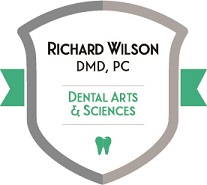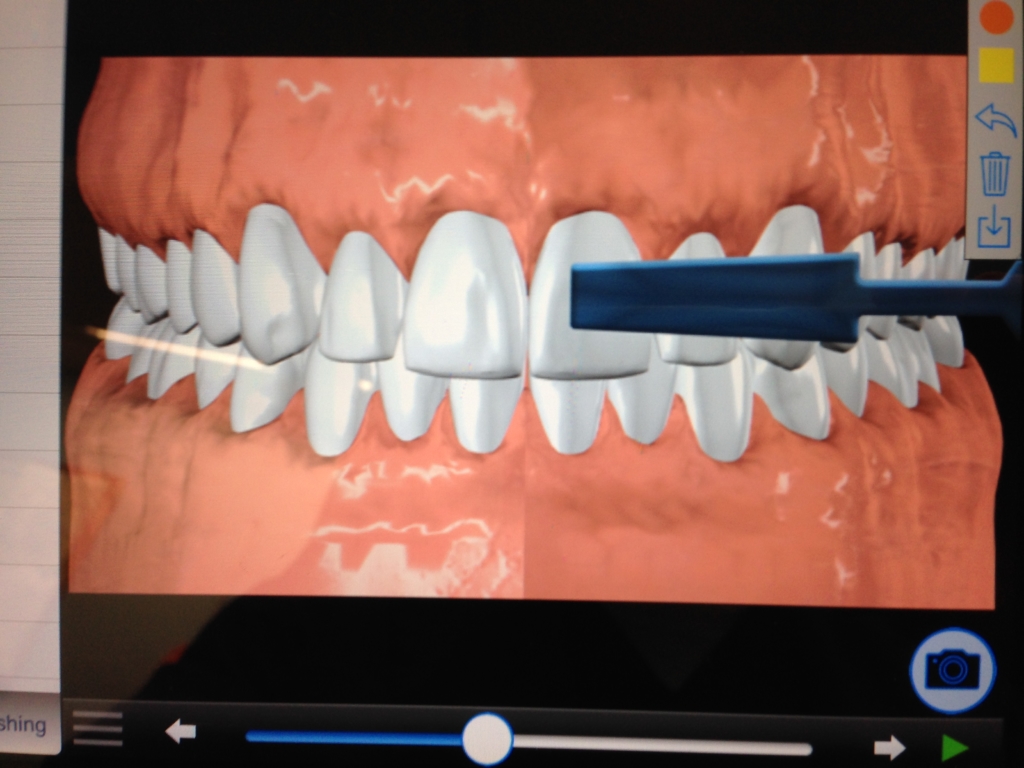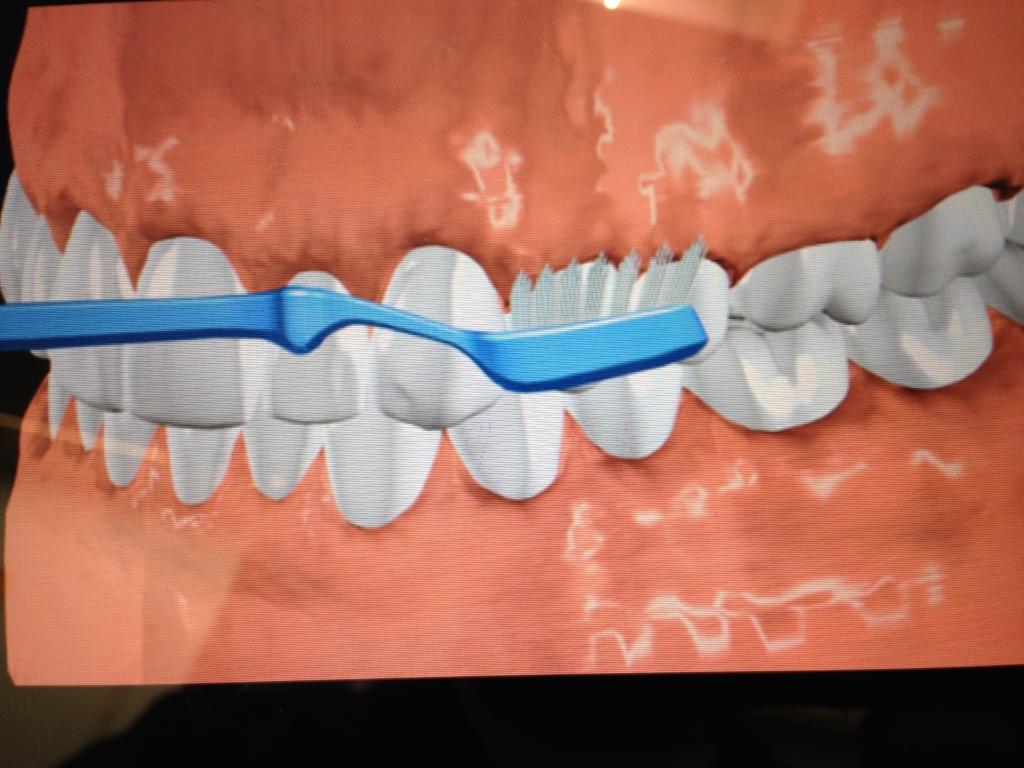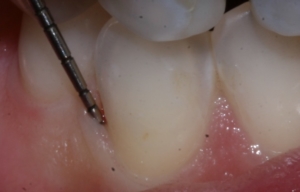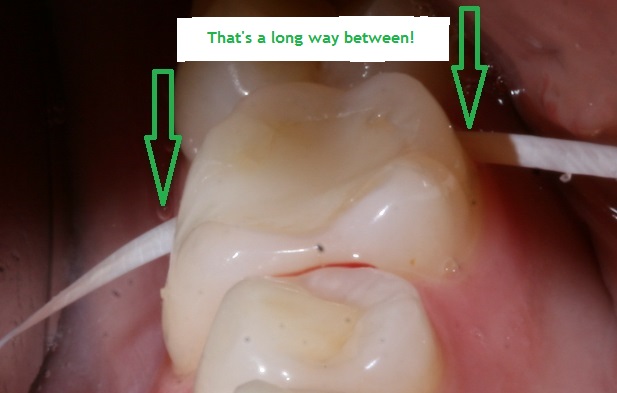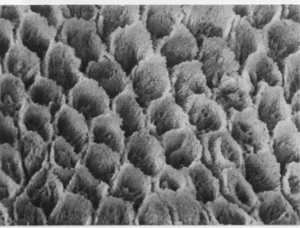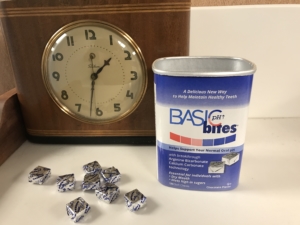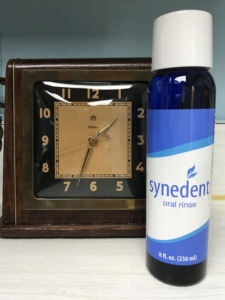How to Prevent Cavities – Part III
Brushing
Brushing our teeth is, naturally, an important tactic in preventing decay. Brushing does a lot of useful things, two of which are to clear away sugars from the teeth and to keep the Strep mutans counts down. The less of that germ hanging around, the less chance of cavities.
We reviewed brushing methods before, but they bear repetition. Many of us brush this way, straight on to the teeth:
This isn’t harmful, but it’s not the most effective way. To best clean our teeth and gums, we should angle the brush into the gums at around 45 degrees, like so:
This applies to both manual and electric toothbrushes.
This angled technique works because our gums don’t fully attach to our teeth; there’s a little collar that’s free. For preventing both tooth decay and gum disease, cleaning between the free gum collar and the tooth is probably the most important place to clean. In this photo, we are measuring that collar, which is a super-healthy one-millimeter on this lovely lower canine.
The bacteria in that little collar are downright vicious. Keep it clean, folks.
Flossing
Flossing or using other methods, like SoftPics, is highly effective. So no, we won’t be one of those practices that gets hung up about floss and floss alone. The thing is though, something has to get between the teeth to clean the small spot beneath where they touch each other.
For the front teeth, it’s not too difficult. Front teeth are sort of flat and so the distance from lip to tongue is not great–even a toothbrush has a shot at cleaning the plaque from this area.
In the back, though? On our molars, there’s a long tunnel from cheek to tongue:
Floss or a toothpick or one of its modern variants is necessary to get rid of the plaque there.
Fluoride
Our tooth enamel is mainly made up of gazillions of mineral crystals with the delightful name hydroxyapatite.
Fluoride is a mineral. It can substitute for calcium in the crystal structure of tooth enamel and this substitution makes the tooth much more resistant to acid attack.
Fluoride is applied topically in toothpastes and in some (but not all) areas it is added to the municipal water supplies. Other things being equal, people who grow up in fluoridated areas and brush with fluoride-containing toothpaste tend to have less cavities than those who do not. Every defense can be overcome though, and if we eat or drink sugar too frequently, fluoride will not in itself be enough to protect us, and we will likely experience cavities anyway.
Fluoride can be a somewhat controversial substance. The Wikipedia page on fluoride is, at the moment, balanced, and can be expected to evolve over time with inputs from varied sources:
https://en.wikipedia.org/wiki/Water_fluoridation_in_the_United_States
Basic Bites
New research shows that while Strep mutans and other germs can make our mouths too acidic, in turn, our mouths can create the acidic conditions favored by Strep mutans and other acid-loving bacteria.
We all have preferences about our environment. One person likes the heat turned way up in winter, another cranks the A/C in summer. Florida’s humidity in summer drives someone away, but there’s another person who doesn’t mind it at all. Similarly, bacteria have preferences and thrive in certain environmental conditions but fail to thrive in others.
It turns out that some of us have acidic saliva, while the saliva of others is more alkaline. This is both genetic and dietary. It’s possible to change the acidity in our mouths with changes to our diets, but this is not so easy. Ever try to give up something you love to eat for a long period of time? Dietary change is hard.
For tooth health it is beneficial to have alkaline saliva. Researchers have also discovered that acidic saliva favors sugar-loving bacteria, which then burn the sugars we eat and drink, causing more acidity … it’s a potentially devastating feedback loop. On the other hand, alkaline saliva favors protein-metabolizing bacteria, and these maintain a more alkaline environment around themselves. There’s far less chance of tooth decay when they are present.
Can we engineer this beneficial change without giving up hundreds of the foods we love? The answer is yes. Rinsing with baking soda and water will decrease acidity in our mouths for half an hour or so. A product called “Basic Bites” will achieve the same thing for five hours and more.
http://www.basicbites.com/?gclid=COnptID-0dMCFdmIswodXgIBIQ
From their website:
BasicBites® are mouth-watering, 15-calorie sugar-free chocolate flavored soft chews which coat teeth with a patented blend of essential nutrients that help maintain enamel health. They were developed to help support the teeth of millions of adults and children* who have dry mouth, a sweet tooth, acid erosion or for those seeking additional oral care support.
Although BasicBites may look and taste like a candy, they feature a patented breakthrough technology developed at Stony Brook University School of Dental Medicine that represents a revolutionary advance in oral care.
Each BasicBite contains:
•Arginine and bicarbonate to help maintain the right
acid/alkaline pH balance on your tooth surfaces
•Calcium carbonate to enrich and fortify your enamel
*Recommended for children over six years of age.
We have free samples of Basic Bites in our office.
And they taste great.
Synedent
Synedent is a remarkable and unique rinse.
About a decade ago, a marine biologist noticed that biofilms absolutely will not form on shrimp exoskeletons. Bacteria can “land” there, but they cannot stick and form colonies and weave the polysaccharide nets that we call biofilm. From an evolutionary standpoint, why this would be is hard to say. However, the U.S. military got very interested in this finding and developed a battlefield wound spray. If bacteria can’t adhere to a wound, that wound will be less likely to get infected during and after treatment. That’s a lot better for a soldier than waiting for infection to start and then using antibiotics.
The military research was subsequently released to civilian companies and Synedent is an oral rinse that resulted. The idea is that it disrupts the formation of biofilm around the teeth, on the tongue and cheeks and so on. This means Strep mutans has a harder time attaching to our teeth.
And that means less chance of cavities.
Synedent has a pleasing taste, causes no stain and is affordable since only small amounts are used with each rinse, once or twice a day according to personal preference. While Synedent is derived from shellfish, the allergens are not present, though patients who are allergic to shellfish should consult their allergist before using. We have samples of Synedent in our office and it can be purchased in bulk online.
https://www.synedent.com/
Conclusions
It is possible to stack the odds against ever getting cavities. If we properly clean our teeth each day, use one or more ancillary products, and above all, remain moderate in the frequency of refined sugars in our diets, we can keep our mouths in tune and avoid one of humanity’s most common–and potentially most painful–scourges.
***A discussion of the many specific ways to restore decayed and broken teeth are beyond the scope of this manual. It would end up being as long as the U.S. tax code! What matters today is that every tooth restorative treatment can, and should, be beautiful, and many of these treatments can be adhesive in nature. This means that with intelligent use of today’s technology, we can create high-strength, long-lasting bonds to both tooth enamel and the dentin inside. This modern approach allows us to create beautiful, long-lasting, bonded restorations that preserve as much of your own tooth as possible. When you appoint with us, we will first arrive at your correct diagnosis, and then we can explore restorative methods if they are necessary.
On our next page, we will tackle another scourge–periodontal disease.
https://www.smilephiladelphian.com/periodontal-disease-explained/
